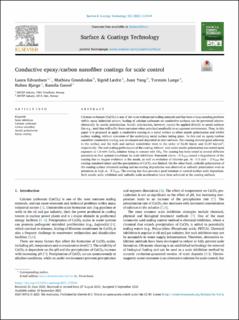| dc.contributor.author | Edvardsen, Laura | |
| dc.contributor.author | Grandcolas, Mathieu | |
| dc.contributor.author | Lædre, Sigrid | |
| dc.contributor.author | Yang, Juan | |
| dc.contributor.author | Lange, Torstein | |
| dc.contributor.author | Bjørge, Ruben | |
| dc.contributor.author | Gawel, Kamila | |
| dc.date.accessioned | 2022-02-04T09:21:21Z | |
| dc.date.available | 2022-02-04T09:21:21Z | |
| dc.date.created | 2021-09-10T11:08:54Z | |
| dc.date.issued | 2021 | |
| dc.identifier.citation | Surface & Coatings Technology. 2021, 425 . | en_US |
| dc.identifier.issn | 0257-8972 | |
| dc.identifier.uri | https://hdl.handle.net/11250/2977086 | |
| dc.description.abstract | Calcium carbonate (CaCO3) is one of the most widespread scaling minerals and has been a long-standing problem within many industrial sectors. Scaling of calcium carbonate on conductive surfaces can be prevented electrochemically by anodic polarization. Anodic polarization, however, cannot be applied directly to metal surfaces like e.g., steel that will suffer from corrosion when polarized anodically in an aqueous environment. Thus, in this paper it is proposed to apply a conductive coating to a metal surface to allow anodic polarization and inhibit surface scaling, without corrosion of the underlying metal surface taking place. To this end an epoxy/carbon nanofiber conductive coating was developed and deposited at steel surfaces. The coating showed good adhesion to the surface and the bulk and surface resistivities were in the order of 52.80 kΩcm and 31.87 kΩ/cm2, respectively. The anti-scaling performance of the coating without- and under anodic polarization was tested upon exposure to 1.5 wt % CaCl2 solution being in contact with CO2. The coating has been tested at several different potentials to find optimal conditions for scale inhibition. Potentials above +3 VOCP caused a degradation of the coating due to oxygen evolution at the anode, as well as evolution of chlorine gas. At +1.5 and +2 VOCP the coating remained intact and the precipitation of CaCO3 was limited. On the other hand, cathodic polarization of the coating surface enhanced scaling and no coating degradation was observed at cathodic polarization even at potentials as high as -5 VOCP. The coating has thus proven a good solution to control surface scale deposition. Both anodic scale inhibition and cathodic scale acceleration have been achieved at the coating surfaces. | en_US |
| dc.language.iso | eng | en_US |
| dc.publisher | Elsevier | en_US |
| dc.rights | Navngivelse 4.0 Internasjonal | * |
| dc.rights.uri | http://creativecommons.org/licenses/by/4.0/deed.no | * |
| dc.subject | Epoxy coating | en_US |
| dc.subject | Anodic polarization | en_US |
| dc.subject | Carbon nanofiber | en_US |
| dc.subject | Calcium carbonate | en_US |
| dc.subject | Scale inhibition | en_US |
| dc.title | Conductive epoxy/carbon nanofiber coatings for scale control | en_US |
| dc.type | Peer reviewed | en_US |
| dc.type | Journal article | en_US |
| dc.description.version | publishedVersion | en_US |
| dc.rights.holder | 2021 The Author(s). Published by Elsevier B.V | en_US |
| dc.source.pagenumber | 10 | en_US |
| dc.source.volume | 425 | en_US |
| dc.source.journal | Surface & Coatings Technology | en_US |
| dc.identifier.doi | 10.1016/j.surfcoat.2021.127694 | |
| dc.identifier.cristin | 1933160 | |
| dc.relation.project | Norges forskningsråd: 285568 | en_US |
| dc.source.articlenumber | 127694 | en_US |
| cristin.ispublished | true | |
| cristin.fulltext | original | |
| cristin.qualitycode | 1 | |

